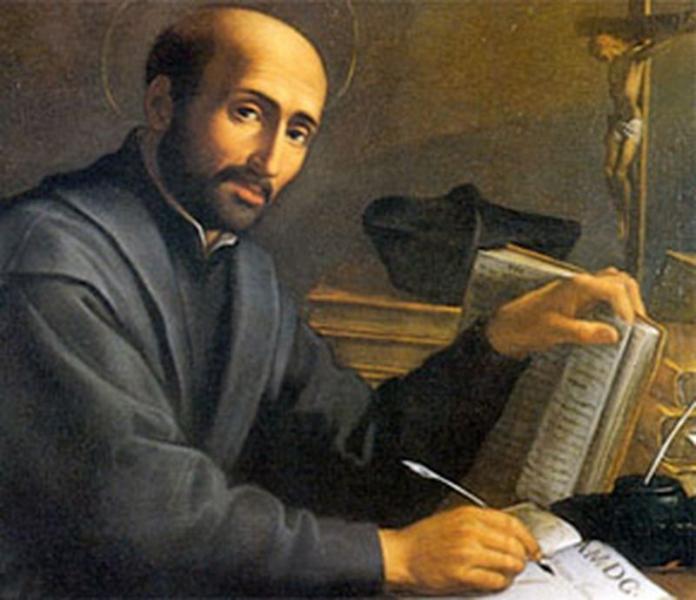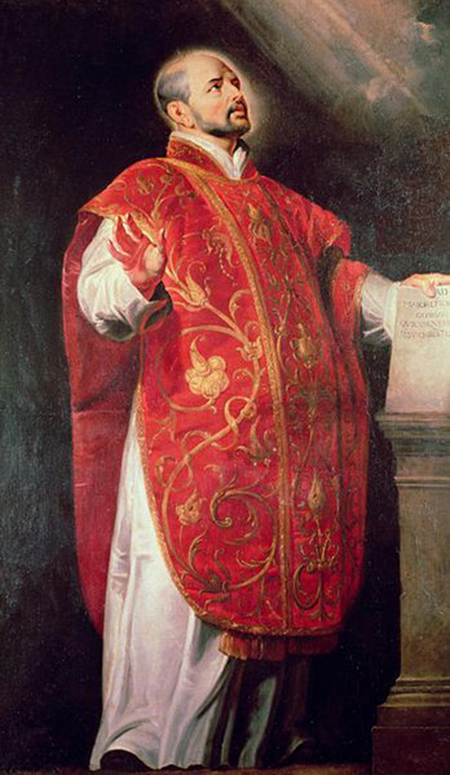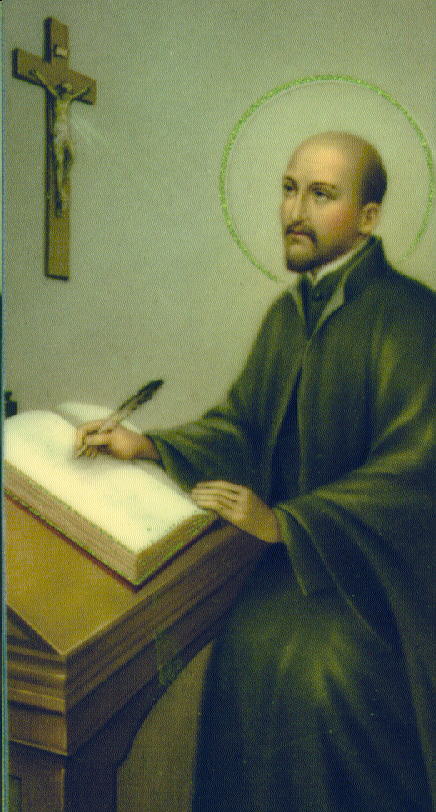
Today is the feast of St. Ignatius of Loyola – that mighty saint who founded the Jesuits in the Fifteenth Century and transformed the Catholic world. Through the rigorous training and use of his Spiritual Exercises, he formed these men to become first-class teachers and defenders of the faith – whilst the Reformation raged and Christendom was breaking down.
During all this, he stood firmly by the Vicar of Christ, the one to whom Our Lord had given absolute authority. And with passion for the faith and devout missionary zeal, he not only helped to save the Catholic faith in Europe, he also set off to convert thousands upon thousands in the new world to the faith.
St. Ignatius was born in 1491, in the Basque country of North West Spain, to a noble family of the house of Loyola. At fifteen, he was sent to the Royal Castilian court, where he was page to the young second wife to King Ferdinand V, with whom he fell in love. He was fully trained as a soldier and fought for the King’s army.
In a battle at Pamplona, he was terribly wounded and primitive surgery caused his right leg to become deformed.
Due to extreme vanity, he desired for this deformity to be corrected and underwent excruciating pain to make it so. This, in turn, brought on a fever and thought to be dying, he was administered the last rites.
On the eve of the Feast of St. Peter, to whom Ignatius was especially devoted, he fervently prayed to the saint to restore him to health. Lo and behold, the following day, on the Feast itself, he did indeed recover. Then, in a long period of convalescence, providence began to transform his heart.
Ignatius was a true chevalier and romantic. Having started life as a soldier and courtier, his head was filled with tales of romance and conquest. In his period of convalescence, he requested books like this to fill the long tedious hours. Yet, none found, he was given volumes on the life of Jesus Christ and of His saints.
Bored at first, Ignatius began to be interiorly moved by these stories, which appeared to him similar to those he was accustomed. Except that the battles waged here, were not for King and country. And the love affairs were not between Chevalier and Lady.

These were stories of battles between good and evil – battles fought for Jesus Christ, by His saints, against the powerful fallen angel, Lucifer. And these were romances between those chosen saintly souls and their only love, Jesus Christ Himself.
Ignatius’ heart became deeply roused as he perused these stories. With greater and greater enthusiasm, each was read and reread. He began to realise this was the battle he desired to wage. For this is the one true battle, the only battle that should be fought.
With this idea, we witness how Ignatius came to understand the world. This allows us to comprehend what he did and why. It is also very important in terms of understanding who he was.
And so who was St. Ignatius of Loyola?
The future saint had been raised in an atmosphere of constant warfare, in his Basque homeland and then in his fighting for the King. He was also born into a world, which had only just witnessed the fall of Constantinople in 1453. These were the facts and events that shaped him. Added to this was the Spanish zest for conquest, which had been fortified by Columbus discovering America.
At heart, Ignatius was clearly a soldier and this shaped his character. He was also a lover, which influenced his passions. But, once converted, through this period of convalescence, his quest for war and love became transformed. The soldier’s determination and the intense zeal of the lover were now focused on a new end.
To sum up, it is crucial to realise how much war was central to Ignatius’ outlook on life. Whether the war was between nations, religions or even different regions of a country, did not matter to him. He saw the world was at war and his conversion showed him that the source of all war was that great battle between good and evil – between Jesus Christ and Satan.
And that battle was being fought, not only in the spiritual worlds, but here on earth, for the souls of humanity. And that battle was waged within each and every individual soul, for every one of us is being fought for. So now, according to St. Ignatius, it was this spiritual war, that was the only one worthy to fight- by the Lord and the Devil.
Sooff he set, in hair shirt and bare feet, to the Benedictine Abbey of Monserrat. There, he hung up his sword at Our Lady’s altar and pledged to fight only for Herself and her Son. He made an incredibly detailed confession and began his new life, of prayer, penance and austerities.
He then retired into the little known town of Manresa, where he attempted to put into practice that which he had learnt through his reading of the lives of the saints.
After many months spent undertaking extreme fasts and mortifications in reparation for his past life of sin, Ignatius became ready to emerge from his hidden life.
And what a different person he now was! For this period of seclusion had proved as extreme in terms of his interior life as it was of his physical penances. This time proved key to Ignatius’ understanding of the war between good and evil within himself, and therefore within the human person.
Here it was his acute observation of how the evil one controls the passions, which led him to begin the writing of his Spiritual Exercises.
He saw how the evil one attempts to trick, persuade and use any possible device, to weaken souls, so that they succumb to temptation. And of course, he saw the greatness of the God-Man and all he had accomplished for us, through His Incarnation, Passion, Death and Resurrection. And he realised that by aligning ourselves to Our God Made Flesh, we could and must fight and win the war against evil.
Ignatius’ meditative Exercises were designed, then, to harness the human will to the Divine Will, in order to overcome the temptations of the devil. Through a deep process of interiorisation, which illumines the consciousness of a person, the individual becomes ever more aware of the inner battle within his soul. One who practices the Spiritual Exercises canmore easily observe the temptations of the devil and develop the strength to resist them, by aligning oneself to the Divine Will.

Once the interior battle was clarified and defined, Ignatius saw that in order to be a true soldier for Christ, he must train his mind through study. And with very little learning to his name, he had to start from scratch.
And so he studied and studied and eventually came to the University of Paris. There, he managed to beg alms to pay for his study and lodgings.
And it was in Paris that he met those who would soon become his companions, Peter Faber (Favre), St. Francis Xavier, James Laynez, Alphonsus Salmeron, Nicolas Bobadilla and Simon Rodriguez. Together these seven men, led by St. Ignatius, formed the original Society of Jesus, commonly known as the Jesuits.
In 1534, on the Feast of the Assumption of the Blessed Virgin Mary, the fifteenth of August, these seven men took themselves to the subterranean chapel on the holy hill, Montmartre, Paris – the very place where the first Bishop of Paris, St. Denis, had been martyred. It was there on that sacred spot that the Society of Jesus was born.
Peter Faber, already ordained, celebrated Holy Mass. As he held the Sacred Host before his companions they spoke aloud their vows. Each then, received Our Lord in Holy Communion.
Many of them had not yet completed their studies, so it was decided they would begin their new life, according to their vows, three years later, in 1537, when they were complete.
In a journal written by Blessed Peter Faber, we read of this memorable occasion:
In this same year, 1534, in August, on the Feast of the Assumption of the Holy Virgin, we, all of us having come to the same resolution, and made the Spiritual Exercises, went to the chapel of Notre Dame, near Paris, and each made a vow to go at the time fixed to Jerusalem, and to place ourselves when we returned in the hands of the Pope … the two following years we all returned on the same day to the same place to renew our resolve, an each time we felt greatly strengthened.
It was a shared desire they held, to go to the Holy Land, to convert the Turks to the true faith. But this trip to Jerusalem was never to be, for war was declared, making it impossible to cross the sea. Providence wanted these fine men in Italy, at the disposal of the Holy Father. So, together they went into battle, winning souls for Christ.
Pope Paul III granted that they would all receive Holy Orders, for they had taken the vow of poverty and achieved the necessary qualifications. Ignatius was ordained on the Feast of St. John the Baptist. He celebrated his first Mass on Christmas Day of that year, 1437.

After living in extreme poverty near Venice, Ignatius was then sited at Rome and began to write the rule for his new company. He was elected Vicar General and was to remain so for the rest of his days.
Through absolute obedience to Rome, he stood resolutely at the right hand of the Holy Father and there, anchored his society. His steadfast allegiance to the Pope meant that he and his Jesuit fathers were at the beck and call of the Vicar of Christ. For this reason, none of the members were permitted to take positions of authority, which would fix them to one particular place, such as a Bishopric.
The Jesuit formation was incredibly rigorous and trained the minds of the young men to be razor sharp. For how else can one defend the faith, particularly at that period in time, when heresy was consuming Europe and destroying Christendom.
Certain Jesuits travelled to Germany to combat the rise of Protestantism, spreading most prolifically in that land. They also fought against Jansenism.
St. Ignatius’ passion and missionary zeal, sent forth members to the far reaches of the earth, to preach and convert the unconverted.
St. Francis Xavier is the most well-known missionary Jesuit regarding the conversion of the Indies, Japan and China. In a letter he wrote to St. Ignatius, he spoke of how his arms ached, for he had to hold them continuously above the heads of those coming to him for baptism.
And with his passion for the conversion of souls, St. Ignatius formed an incredible network of schools for the education for of young men, developing them through rigorous study and prayer, in all that would foster the faith.
St. Ignatius would die in Rome in 1556. But before he did, he had set in motion one of the greatest movements in the history of the Church – one which saved Catholicism in many parts of Europe, as well as provided the means for the Faith to spread out across the face of the earth.
I hope this short reflection on his life and spirituality can provide a little understanding of what he did. But really, no words of mine can begin to suffice.
I know, however, that we again are living in a most dangerous time for the Catholic and Christian faith – one where we need to be strong and faithful as St. Ignatius and his original Jesuits were strong and faithful.
And so I plead and implore:
St. Ignatius – Pray for us!
Foreword for Monarchy by Roger Buck
Buying Books at Amazon Through These Links Gives Us a Commission. This Supports Our Apostolate. Thank You if You Can Help Us Like This!









Comments
comments are currently closed
3 responses to “Feast of St. Ignatius of Loyola”
I really liked your informative article on St. Ignatius.
A belated thank you, Mary Rose!
Dear Kim,
Thank you for this post on St Ignatius. I have read summaries of his spiritual exercises that extend over a four week period. The first three weeks I somewhat have done, repeatedly, however I cannot easily get to the content of the fourth week. (Joy about the Resurrection)
Do you think purchasing a book about his spiritual exercises would be helpful?
💕kelly